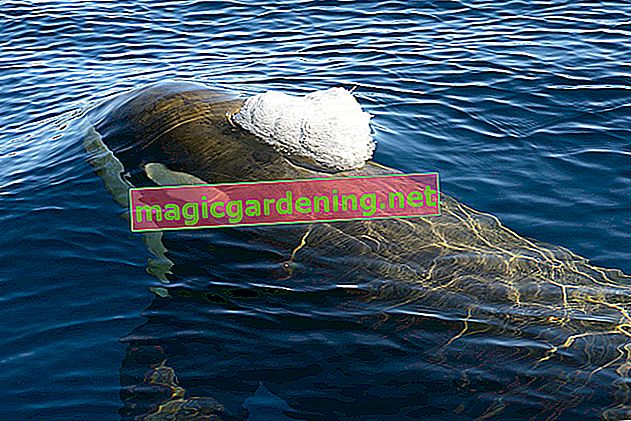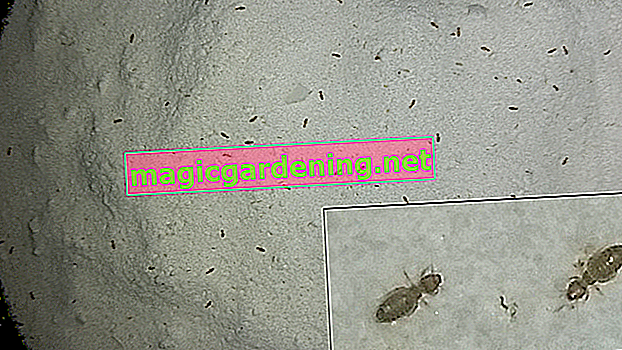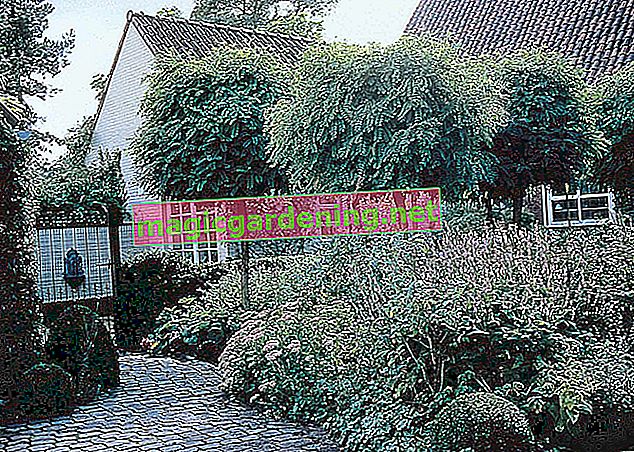
Origin and use
The term “fan palm” does not refer to a specific species or genus, but is a collective term for palm species with hand-shaped, fan-like leaves. There are numerous species that are found in different parts of the world. While the popular Washingtonia species - such as the desert palms Washingtonia filifera or Washingtonia robusta - come from the southeastern USA and northwestern Mexico and are now widespread in the Mediterranean region, the hemp palm (Trachycarpus fortunei) has its natural habitat in the high mountains Asia. In our country, however, these and other species can only be cultivated in pots because of the nonexistent or weak winter hardiness.
also read
- Proper care of the fan palm
- Hibernate fan palm properly
- Which types of fan palms are suitable for the home and garden?
Appearance and stature
Fan palms usually grow solitary and tree-like, even if, strictly speaking, palms are not trees due to the lack of trunk thickening. The upright stems are typically densely packed with ring-shaped leaf scars and covered with dry leaves.
leaves
The various fan palms owe their names to the characteristic structure of their leaves. The single leaves are very large, divided in the shape of a hand and have a fan-shaped outline. The leaf veins are arranged radially from the base of the petiole to the leaf margin.
Toxicity
Since the various types of fan palm belong to the so-called real palms, they are non-toxic and therefore harmless to humans and animals.
Which location is suitable?
Like almost all other palm species, fan palms also need a lot of light - after all, they are plants that are found in nature in very exposed locations, in the case of Washingtonia, for example, in the desert. Place the potted plants as brightly and warmly as possible at temperatures between 20 and 25 ° C, although direct sunlight over the midday hours should be enjoyed with caution: This can lead to leaf burns, which is why shading the plants makes sense.
Substrate
Palms feel most comfortable in a special palm substrate. If you want to mix the substrate yourself, however, choose coarse sand, which you mix with compost, peat and expanded clay (€ 17.50 on Amazon *) in equal parts. A high mineral content in the substrate is advantageous for the plants, and it also increases the permeability of the mixture. Palms are usually used to drought and do not tolerate excessive moisture - especially no waterlogging.
Water fan palm
Especially in spring, during the main growing season, you should provide fan palms with sufficient water. For this purpose, always keep the soil slightly moist, but not wet, and do not water too abundantly at once - frequent and heavy watering not only leads to waterlogging (which palms do not like at all), but also removes minerals and nutrients from the substrate . Do the finger test before every watering: If the substrate has dried on the surface, watering is allowed - otherwise not. During the hot and dry summer months, it is also useful to moisten the leaves from time to time, for example with lime-free water from an atomizer, so that the large leaves stay nice and green and do not turn brown.
Always use lime-free water to water the fan palms. By using tap water, the plant will die sooner or later.
Fertilize fan palm properly
Fan palms need a balanced nutrient cocktail for healthy and beautiful growth. Provide the plants with a liquid complete fertilizer between April and August, which contains in particular nitrogen (for the growth of leaves and shoots), phosphorus (development of healthy and strong roots) and potash (for stability). You can use special palm fertilizers, but this is not absolutely necessary. Always apply the fertilizer together with the irrigation water and never dump it on a dry substrate.
Cut fan palm correctly
In contrast to the so-called false palms - such as the yucca palm, which is also widely used as an indoor plant - you must not simply cut fan palms if they get too high. Cutting off the tip then often kills the whole plant. Only remove dried, brown or yellow fronds, whereby you must not leave any residues on the trunk - these serve as a welcome breeding ground for pathogens and parasites. If possible, pruning is done before putting it in the winter quarters. When cutting, be careful not to injure yourself on the thorns.
Continue reading
Repot
In early spring, the palms need to be repotted so that the potted plant can then switch to the growth phase with fresh substrate and a larger pot. Do not knock the old soil out of the roots, but put it into the fresh substrate - this makes it easier for the plant to grow. In addition, the new plant pot should be a few sizes larger, although the Washingtonia species in particular also need deep planters: They form a deep taproot. The right time to repot has come when the roots start to grow out of the pot.
Continue reading
Overwinter
As a rule, fan palms withstand low temperatures of around minus eight degrees Celsius quite well. Good protection from the cold is still important, especially if the plant is to stay outside over the winter months. To do this, however, the palm must be packed well:
- Tie the fronds up with a thin rope.
- Put an airy, large sack (e.g. made of jute) over the palm.
- Styrofoam sheets, arranged around the palm and tied down, also protect against the cold.
- Cover the trunk with dry mulch material or a bamboo mat.
- Mulch the substrate to protect the roots.
However, if long or deep frosts are to be expected, you should move the palm tree to a cool, but frost-free and, above all, light winter area. Water only a little, there is no fertilization at all until April. Wintering in the living room is also possible, but difficult because of the dry heating air and the lack of light in the winter months. Keep the humidity high and install additional grow lights if necessary.
Continue reading
Diseases and pests
Fan palms are often attacked by woolly, mealybugs and scale insects, which are difficult to spot because of their color. You should therefore check the plants regularly for an infestation so that you can intervene quickly and prevent an invasion in good time. Incidentally, the first signs are often brown or yellow discolouring fronds. In general, palms react with such discolored leaves if they do not feel well: too dark a location, cold, insufficient fertilization and overwatering (waterlogging) or drought can also result. If brown or yellow leaves appear on your fan palm, you should carefully look for a cause and, if found, remedy it accordingly.
Tips
You can grow fan palms yourself from seeds that you can buy in specialist shops. You will need patience, however, as it will take several months to germinate.
Species and varieties
Usually the three species Washingtonia filifera, Washingtonia robusta and Trachycarpus fortunei are assigned to the fan palms, sometimes the Livistonia, which actually belongs to the umbrella palms, but externally quite similar, is also included in this group.
Washingtonia filifera
Washingtonia filifera is a robust, fast-growing palm species that is used to dry locations and that has its desert home in the southern United States and Mexico. In their natural environment, these fan palms can grow up to 15 meters high and reach a trunk diameter of approx. One meter - this is of course not possible in a bucket culture, here the plant remains significantly smaller. Pay attention to the thorny leaf stalks, which are easy to injure yourself.
Washingtonia filifera is also known colloquially as the priest palm or petticoat palm, which is due to the numerous, dried-up brown leaves that cover the trunk. However, in a room culture, you can safely remove these. Washingtonia filifera can withstand a bit of frost for a short time, but should be wintered frost-free.
Washingtonia robusta
Washingtonia robusta is very similar in appearance and growth to the species Washingtonia filifera, but is considered to be more robust and insensitive - just not to cold, because in contrast to W. filifera, W. robusta can withstand temperatures of no more than minus five degrees Celsius for a short time. The species has its home in northwestern Mexico, where it is usually a little more humid than in the ancestral home of W. filifera.
Trachycarpus fortunei
The Chinese hemp palm grows in a rather unusual climate for palm trees, namely in the heights of the Asian high mountains up to 2500 meters above sea level. As a result, this species is particularly suitable for a culture in the Central European climate, since it is used to a rather cool climate by nature. The species feels particularly comfortable in a bright location with temperatures between 15 and 20 ° C. Older specimens can also tolerate frost down to around minus ten degrees Celsius for a short time, but should be wintered as cool and frost-free as possible. The hemp palm is often confused with the dwarf palm (bot. Chamaerops humilis) and is therefore mistakenly often found in stores under this name. However, they are different species with different needs.
Livistonia / Livistonia
Although the different species of Livistonia palms are often assigned to the fan palms, they are actually umbrella palms. Livistona australis, Livistona chinensis and Livistona rotundifolia are particularly popular as houseplants. All species should be cultivated all year round at temperatures between 20 and 25 ° C, although you can also put them outside in summer. The palm trees need a bright location (but without the midday sun) and only little water.








